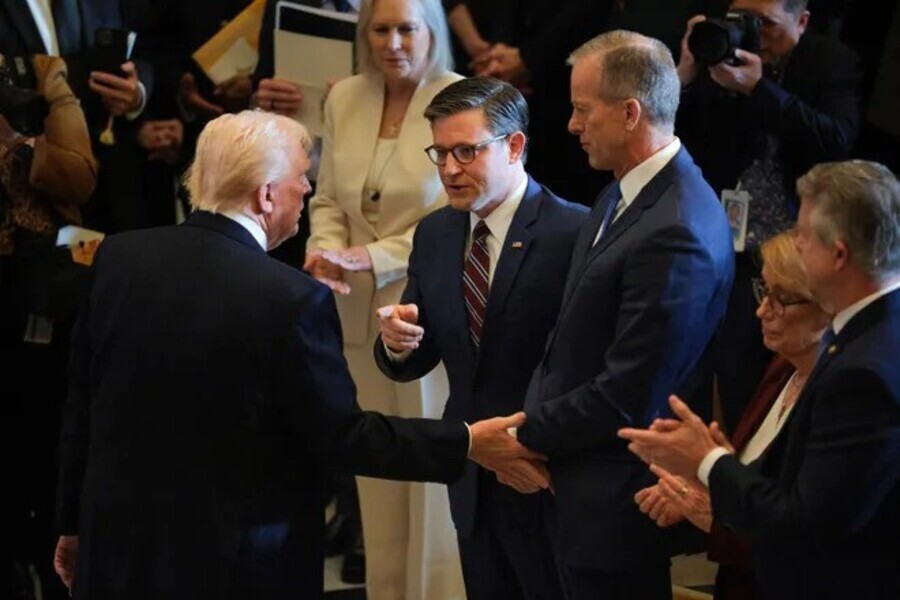Tensions are escalating in Congress as Republicans struggle to find common ground to push forward President Donald Trump’s legislative agenda. With both chambers under GOP control, lawmakers are racing to fulfill campaign promises on immigration, tax cuts, defense spending, and energy policy before time runs out.
The pressure to deliver is palpable. Trump has summoned Republican senators to a private dinner at Mar-a-Lago on Friday, a day after House Republicans huddled at the White House for a marathon meeting. On Sunday, House Speaker Mike Johnson will accompany the president to the Super Bowl, signaling an effort to maintain unity within the party amid growing divisions.
Despite these high-profile gatherings, the path forward remains unclear. House Republicans have been at an impasse over a budget framework that would set spending limits and cuts. The disagreement is significant because both the House and Senate must pass the same bill to unlock the budget reconciliation process. This mechanism would allow Republicans to bypass a Democratic filibuster in the Senate and pass legislation with a simple majority.
However, the slim Republican majority in both chambers complicates matters. In the House, a narrow 217-215 margin leaves little room for error. The situation is further strained by recent vacancies and the upcoming resignation of Rep. Elise Stefanik, R-N.Y., who has been nominated as ambassador to the United Nations.
House leaders have advocated for a comprehensive “big, beautiful bill,” as Trump has called it, to address multiple issues at once. This strategy aims to secure support from various factions within the party but has faced pushback from both moderates and hardline conservatives.
In the Senate, where the GOP holds a comfortable majority for simple votes but lacks the 60 votes needed to overcome filibusters, Budget Committee Chair Lindsey Graham is growing impatient. On Wednesday, he announced plans to proceed with a two-bill strategy. One bill would cover defense, immigration, and energy, while the other would focus on tax reform.
“It’s time for the Senate to move,” Graham said, emphasizing the importance of funding border security initiatives. His plan includes $175 billion for border security measures and $150 billion for national defense.
The Senate’s move risks deepening the divide between the two chambers. If Graham’s blueprint passes before the House finalizes its version, House Republicans will face a tough decision: either accept the Senate’s plan or delay Trump’s agenda further.
House Republicans have been under intense pressure to produce results. They recently held a three-day retreat at Trump’s Miami resort to discuss their budget framework but left without a consensus. The core issue is the potential cost of Trump’s proposed tax cuts, which could amount to trillions of dollars. Members of the conservative Freedom Caucus are demanding significant spending cuts to offset the tax reductions.
“If you’re going to have tax cuts, you’ve got to have spending cuts,” said Rep. Chip Roy, R-Texas. “It’s got to reduce the deficit.”
The federal debt ceiling is also a point of contention. The government is expected to hit its borrowing limit later this year, and House leaders have signaled that raising the debt ceiling will likely be part of the reconciliation package. Freedom Caucus members argue that including the debt ceiling in the bill is crucial to avoid giving Democrats leverage in negotiations.
Meanwhile, the White House has outlined its priorities for Trump’s legislative agenda. Press Secretary Karoline Leavitt stated that the president is pushing for a historic tax cut for middle-class Americans. His proposals include eliminating taxes on tips, Social Security benefits, and overtime pay. Additionally, Trump wants to close loopholes benefiting wealthy sports team owners and extend tax cuts implemented during his first term.
“This will be the largest tax cut in history for middle-class working Americans,” Leavitt said.
Trump has made it clear that he expects Congress to deliver on these promises, though he has not specified how lawmakers should achieve them. This ambiguity has led to friction between House and Senate Republicans, each of whom has their legislative approach.
Senate leaders have indicated they will give the House time to finalize a budget plan but are prepared to move forward independently if necessary. Graham’s budget proposal is expected to go before the Senate Budget Committee next week.
House Appropriations Chair Tom Cole, R-Okla., acknowledged the urgency of passing a budget blueprint. He warned that failure to act would result in the expiration of Trump’s 2017 tax cuts, leading to one of the largest tax increases in U.S. history.
“If you don’t get that reconciliation package, you’re going to have the largest tax increase in American history,” Cole said. “That’s just not what God made Republicans to do.”
The battle over Trump’s agenda highlights the challenges of governing with narrow majorities. Republicans are acutely aware that their control of Washington may only last until the next election cycle. Historically, the party in power often loses congressional seats in midterm elections, putting additional pressure on GOP leaders to secure major legislative victories.
As both chambers grapple with competing strategies, the stakes could not be higher. The outcome of these negotiations will not only shape Trump’s legacy but also determine the Republican Party’s ability to maintain its hold on power in future elections. For now, the clock is ticking, and all eyes are on Capitol Hill as lawmakers work to break the stalemate.

